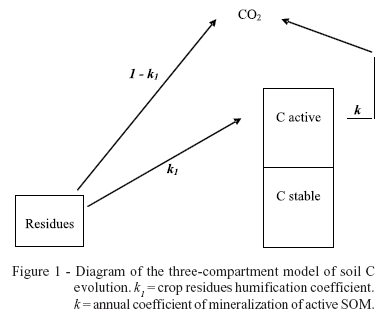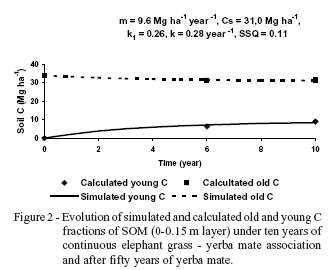Highly weathered tropical soils rapidly loose soil organic matter (SOM) and may be affected by water erosion and soil compaction after deforestation and intensive cultivation. With the main objective to estimate the SOM balances in a subtropical soil we determined the dynamics of SOM in a degraded yerba mate (Ilex paraguaiensis Saint Hil.) plantation introduced after deforestation and with elephant grass (Pennisetum purpureum L.) as a cover crop. The study site was in Misiones, Argentina, and we use the natural 13C abundance methodology and a descriptive model. The study was conducted on three contiguous 50 x 100 m plots of a typic Kandihumult soil with: (i) native forest, (ii) 50 years of continuous yerba mate monoculture with intensive tillage, and (iii) yerba mate associated with elephant grass as a cover crop and no tillage. We determined bulk density, carbon (C), nitrogen (N) and 13C content of the soil (0 - 0.05, 0.05 - 0.15 m layers) and the grass biomass. Yerba mate monoculture reduced soil C and N content as well as porosity at 0 - 0.15 m depth by 43 and 23%, respectively, as compared to the native forest. After ten years of yerba mate - elephant grass association soil C and N contents at the same depth increased by 19 and 12%, respectively, compared to the yerba mate monoculture, while soil porosity remained similar. Total C input,13C, and soil organic C were incorporated into a three compartment model to evaluate elephant grass C dynamics. Through the natural 13C abundance methodology we tracked the elephant grass C incorporation and the "old" soil C loss, and determined the model parameters - humification (k1) and mineralization (k) coefficients and stable C (Cs)- unambiguously. The high k1 and k predicted by the model are probably explained by elephant grass root system incorporation under no tillage and humid subtropical climate, respectively. In soil under yerba mate monoculture, Cs was counted as 91% of the total soil organic C.
Ilex paraguaiensis; Pennisetum purpureum; natural 13C abundance; soil carbon; modelling












